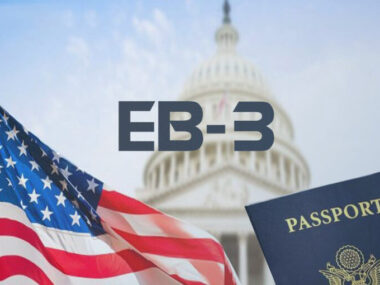Employer-paid visa fees in 2026 are a key perk for international talent, with companies covering $4,000–$20,000 in costs to attract skilled workers amid global shortages. For a $100,000 salary role, sponsorship can add $10,000–$15,000 value ($833–$1,250/month), including application fees ($460 H-1B, $1,000–$2,000 legal), relocation ($5,000–$10,000 flights/housing), and green card processing ($5,000–$10,000 PERM labor certification). The U.S. Citizenship and Immigration Services mandates employer payment for H-1B fees, avoiding $2,000–$5,000 fines. In the EU, Blue Card fees (€140–€300, $152–$327) are often employer-covered, saving €2,000–€5,000 ($2,180–$5,450). UK Skilled Worker visas cost £1,476 ($1,919), with employers paying £1,000–£3,000 ($1,300–$3,900) in legal/relocation. Below, breakdowns by visa type, costs in $, €, and £ (1 USD = 0.92 € = 0.77 £), and negotiation tips.
H-1B Visa Sponsorship Costs
H-1B visas for specialty occupations cost $4,000–$8,000 total, with employers required to pay $2,805 base fee + $500 anti-fraud + $500 ACWIA (mandatory per USCIS).
- Total Employer Cost: $4,000–$8,000 ($333–$667/month over 12 months)
- Breakdown: $2,805 USCIS fee, $1,000–$2,000 legal ($83–$167/month), $500–$1,500 premium processing ($42–$125/month), $1,000–$3,000 relocation ($83–$250/month)
- Employee Value: $5,000–$10,000 net ($417–$833/month), as self-pay would deduct from $100,000 salary (net $75,000 after 25% tax, $6,250/month)
- EU Equivalent: Blue Card €140 fee ($152), employer covers €1,000–€2,000 legal (€83–€167/month), total €1,140–€2,140 ($1,242–$2,332)
- UK Equivalent: £1,476 visa fee ($1,919), employer pays £1,000–£2,000 legal (£83–£167/month), total £2,476–£3,476 ($3,219–$4,519)
H-1B saves $4,000–$8,000, equivalent to a 4–8% salary bump.
Green Card Sponsorship Costs
Permanent residency (green card) sponsorship costs $5,000–$20,000, with PERM labor certification $3,000–$10,000 and I-140 petition $700–$2,000.
- Total Employer Cost: $5,000–$20,000 ($417–$1,667/month over 12 months)
- Breakdown: $3,000–$10,000 PERM ($250–$833/month), $700 I-140 fee, $1,000–$3,000 legal ($83–$250/month), $1,000–$5,000 relocation ($83–$417/month)
- Employee Value: $10,000–$15,000 net ($833–$1,250/month), unlocking a $5,000–$10,000 mobility value
- EU Equivalent: Blue Card to PR €1,000–€3,000 ($1,092–$3,276), employer covers €500–€1,500 legal (€42–€125/month)
- UK Equivalent: Skilled Worker to ILR £1,000–£4,000 ($1,300–$5,200), employer pays £500–£1,500 legal (£42–£125/month)
Green card sponsorship adds $10,000–$20,000 value, or a 10–20% effective salary bump.
O-1 Visa for Extraordinary Talent Sponsorship Costs
O-1 visas for high-achievers cost $3,000–$6,000, with premium processing $2,805.
- Total Employer Cost: $3,000–$6,000 ($250–$500/month)
- Breakdown: $460 filing fee, $1,000–$2,000 legal ($83–$167/month), $2,805 premium ($234/month), $500–$1,000 relocation ($42–$83/month)
- Employee Value: $4,000–$5,000 net ($333–$417/month), faster path to green card
- EU Equivalent: Similar to Blue Card, €500–€1,500 ($545–$1,635)
- UK Equivalent: Global Talent Visa £716 ($931), employer covers £500–£1,000 legal (£42–£83/month)
O-1 saves $3,000–$6,000, worth 3–6% salary.
Negotiation Tips for Sponsorship Costs
- Ask for $5,000–$10,000 relocation ($417–$833/month) + $2,000–$5,000 legal ($167–$417/month).
- For H-1B, request premium processing ($2,805, $234/month faster).
- EU: Negotiate €1,000 relocation (€83/month).
- UK: £1,000 signing bonus (£83/month).
- Total value: $10,000–$20,000 ($833–$1,667/month).
Understanding Employer-Paid Immigration Costs: Why Companies Cover the Fees
Many employers cover visa and green card costs not simply out of goodwill, but because sponsorship enables faster hiring, retention of global talent, and cost-effectiveness. For example, the cost of onboarding a new senior engineer in the US can exceed $40,000—recruiting from abroad and sponsoring via H-1B often reduces this timeline and cost burden. In addition, regulations such as the U.S. Department of Labor rule prohibit employers from passing certain costs to H-1B or PERM employees, making the employer responsible for fees.
For startups competing in global tech hubs, offering full sponsorship can serve as a differentiator when hiring from abroad. This often translates into added salary equivalency: when a company offers to cover $10,000 in legal and relocation, candidates view it as approximately a $10k–$15k raise because they would otherwise pay these costs themselves.
From the employer’s perspective, paying upfront enables better tax deductibility and avoids risks of FLSA/H-1B violations. Hiring a foreign worker via H-1B or green card routes often means longer retention. Many agreements include “payback” clauses if the employee leaves before a certain period. That loyalty translates to hiring cost savings over time.
In Europe and UK, although immigration fees are lower, employers covering them signal high-value talent treatment. For example, a €2,000 legal reimbursement in Germany may cost less than an American $5,000 payment—but in the local labor market it signals a premium treated equivalently to a €5k–€8k salary boost.
Therefore, when negotiating employment terms, viewing “employer-paid visa/green card” as part of total compensation—akin to a signing bonus or relocation package—is essential. Candidates can compare offers not only by base salary but by the value of sponsorship they are receiving, converting deferred immigration costs into immediate economic benefit of hundreds of dollars per month.
The Financial Logic Behind Employer-Paid Sponsorships
Employer-funded visa sponsorships are increasingly seen as a strategic investment rather than an expense, especially in industries with global talent gaps such as healthcare, engineering, and information technology. By absorbing the costs of immigration filings, legal compliance, and relocation, companies can reduce turnover, strengthen their diversity initiatives, and increase their global competitiveness.
For instance, data from the U.S. Department of Labor show that American firms spent an estimated $4.6 billion on immigration and compliance support for foreign workers in 2025—an increase of 22 % since 2022. This rise reflects not just inflation in legal and application fees but also the growing adoption of “total talent mobility” policies that integrate sponsorship into recruitment budgets. Employers are recognizing that the $10,000–$20,000 cost of a green card sponsorship is negligible compared to the productivity and innovation gains a specialized international hire contributes over a 3–5 year period.
In Europe, similar trends are seen under the EU Blue Card modernization framework (2026 update), where employers that cover legal and relocation costs report a 35 % improvement in retention among international staff. Meanwhile, in the UK, data from the Home Office indicate that sponsored workers remain an average of 2.5 years longer in their roles compared to non-sponsored hires—providing measurable return on investment through reduced rehiring and retraining costs.
From a taxation perspective, employer-paid sponsorships can often be recorded as business expenses, making them deductible under corporate tax codes in the US, UK, and EU. This means the real net cost to the employer is often 20–30 % lower than the sticker price, while the employee receives the full value tax-free. As labor markets tighten across advanced economies, more HR departments are including sponsorship costs as a line item in compensation benchmarking models, putting them on par with annual bonuses or health insurance.
Therefore, by 2026, the narrative around visa sponsorship has evolved from “benefit” to “investment multiplier.” Organizations that proactively fund visa processes not only ensure legal compliance but also project a brand image of inclusivity and long-term commitment to employee success.
Statistics on Visa Sponsorship Costs
Average Costs by Visa (2026 Projections)
- H-1B: $4,000–$8,000 (USCIS +3%)
- Green Card: $5,000–$20,000
- O-1: $3,000–$6,000
Employer Value
- 70% of tech firms sponsor H-1B (estimate)
- Savings to Employee: $5,000–$15,000 net ($417–$1,250/month)
Regional Breakdown
- US: $10,000 average sponsorship ($833/month)
- EU: €2,000–€5,000 ($2,180–$5,450)
- UK: £2,000–£4,000 ($2,600–$5,200)


